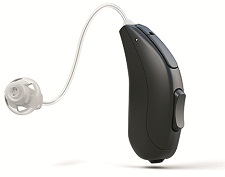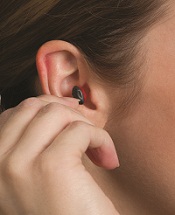Interview with John Cariola, Au.D., Director of Product Management, Beltone
CAROLYN SMAKA: Today I’m talking with John Cariola from Beltone about a new product line they have just released. John, can you give an overview?

JOHN CARIOLA: Yes, the new product line is called the Beltone Promise™. The Promise 17 is positioned in our top technology segment, and there is also a Promise 9 which is in what we call our Plus segment. The Beltone Promise is a full portfolio of styles that includes BTEs, RIE’s and custom products including the mic-in-concha, where the microphone is taken out of the instrument and placed externally in the helix area of the ear. In addition, we have introduced a new micro CIC instrument, the micro-Invisa™, which is available in our two top technology segments as the micro-Invisa 9 and the micro-Invisa 17.
These circuits use our industry-leading 2.4 GHz wireless technology for Ear-to-Ear Synchronization. Promise allows the wearer to change the volume or program settings on both instruments by only adjusting one instrument of the set. Promise’s CrossLink Directionality feature automatically adjusts the directionality pattern for each instrument with no input from the wearer.
With the CrossLink Directionality, the hearing aids communicate with each other while sampling the sound environment. They automatically determine if both instruments should be omni-directional, if both instruments should be directional, or if one should be directional and the other omni-directional. The decision is based on which arrangement will provide the best signal-to-noise ratio.

CAROLYN: Can you give an example of when one particular arrangement of directionality might be selected?
JOHN: Sure. For example, if the environment is quiet with little to no speech, both hearing aids will likely be in an omni-directional mode. If the environment starts to get noisy, the instruments will use their environmental classifiers to analyze the situation, and then seamlessly transition to dual directionality if there is a lot of noise. Then, they will transition back to completely omni-directional when it is quiet. So the hearing aids are automatically monitoring the environment and then switching as needed, to provide the wearer with the best signal-to-noise ratio.
 CAROLYN: In addition to CrossLink Directionality and Ear-to-Ear Synchronization, what other new features does the Beltone Promise encompass?
CAROLYN: In addition to CrossLink Directionality and Ear-to-Ear Synchronization, what other new features does the Beltone Promise encompass?
JOHN: One great new feature makes it easier to use the telephone. As we know using the telephone can be challenging for people who wear hearing aids. Beltone Promise has what we have termed asymmetrical phone handling. What this means is that when you hold the phone up to one hearing instrument, it will automatically move in to the phone program in that instrument and at the same time, decrease the gain slightly in the non-phone instrument on the opposite ear. The listener can thus hear more easily on the phone yet still monitor what’s going on around them.
CAROLYN: That sounds intuitive and functional. Does Promise offer anything new in terms of feedback suppression or music listening? Those are two other key issues for people with hearing loss.
JOHN: Beltone Promise has Feedback Eraser™ with WhistleStop™, which is one of the best feedback systems available. It also features a new AFX music mode. What we found was that when listening to music, there are times when certain instruments will generate pure tones, for example, when there is a flute or other orchestral instrument in the music. Other systems will be confused by these sounds, sometimes thinking they are feedback, and then change the gain or produce artifacts. The AFX music mode is an alternate feedback algorithm that monitors these inputs in an optimum manner with a longer sampling time, giving the wearer a better experience for music listening.
In addition, we still have one of the best noise reduction systems. The hearing aids monitor what sound environment the listener is in, and then they modify the gain automatically when the environments change. It determines whether the environment contains speech, no speech, loud speech, loud noise, or no noise and automatically adapts - it’s like having several automatic programs. The automatic processing in the Promise instruments makes wearing a hearing aid much more transparent, so the patient doesn’t have to make a lot of choices by changing programs or pressing buttons to manage a situation. The Promise instruments also feature our wind noise reduction system, which works very well for people that are more active outdoors.
The Promise is also compatible with wireless connectivity devices like the myPAL.
CAROLYN: Before we get in to the micro-Invisa, can you tell me about the Promise BTE models?
JOHN: Let’s start with the 85DLW; D stands for directional, L stands for light or LED, and W means wireless capability. This instrument will be released into the line at the beginning of 2013. The LED light makes Promise an ideal instrument for patients working with a third party, whether it’s a teacher, caregiver or family member. The LED light enables the third party to monitor whether the instrument is working appropriately. They can easily determine whether the instrument is on or off, and what program it is in. This instrument also has a very durable battery door lock system. This is a good instrument for patients who are under the care of nursing home staff or a caregiver. This new BTE uses a size 13 battery.
In addition, on this new model, as well as the Promise 17 and Promise 9-78DW, there is a new, metal ear hook option. With the metal hook, the instrument can provide 5 to 7 dB more gain due to added stability. While it doesn’t add additional output, it does give more gain when needed simply by replacing the standard hook with the new metal hook.
 CAROLYN: Switching gears to the micro-Invisa™ – how we you able to accomplish such a small micro-CIC design?
CAROLYN: Switching gears to the micro-Invisa™ – how we you able to accomplish such a small micro-CIC design?
JOHN: The micro-Invisa is our smallest CIC. We were able to take some of the programming components out of the shell by using a through-the-door programming connection, which gave us more internal space. We were then able to recess the faceplate deeper into the canal.
CAROLYN: Does this mean that a special deep impression is needed?
JOHN: The same impression that is used for a regular CIC is all that’s needed. You want to get a full impression past the second bend. We’ve provided an otolight that has a 16-millimeter marking on it to help place the otoblock. We also offer a tool to measure the width and the height of the canal to make certain that person is a candidate. While most patients will be candidates, the measuring tool can assist if a patient has sharply bending canals or very small canals, so you can know if we will be able to make a satisfactory product before you send it in. What’s great is that the micro-Invisa doesn’t require that the professional do anything differently than what they are already doing. Some professionals have moved away from custom products in the past few years due to all the great BTE, RIC and slim-tube options available, so they may need to simply get comfortable with taking impressions for custom products again.
CAROLYN: I agree. Having a one-piece instrument that sits discreetly in the ear is an advantage and what some patients are still looking for, even with all the great slim-tube and RIC BTE options.
JOHN: Yes, and as I mentioned, the faceplate of the micro-Invisa sits deeper into the opening of the ear canal than a traditional CIC. The faceplate is a color called anthracite, which is similar to charcoal, and looks like a shadow in the ear. To help people determine which is the right instrument and which is the left, the shell is either a red (right) or a blue (left) transparent color, so it’s easy for patients to tell the hearing aids apart. The micro-Invisa has a similar feature set as the Promise 17 and Promise 9 and includes the AFX music mode and the feedback cancellation system. However, being a CIC, it doesn’t have directional microphones and on-board controls, but it does include the new technology and is a great product for someone who wants a one-piece instrument and the best possible cosmetic solution.
CAROLYN: I’m assuming all the new technology you mentioned in Promise and micro-Invisa is due to a new chip?
JOHN: Yes, this technology utilizes a brand new digital chip that we refer to as “ Coyote”. This is Coyote 4.5, and offers more memory for processing and a faster processing speed than the previous version. There has been an improvement on all the existing systems because we’ve improved the chip itself. This new chip provides improved battery life, more memory, and the capability to perform more sophisticated algorithms for noise and feedback reduction.
CAROLYN: You and I spoke a while back about Beltone’s tinnitus-masker option. Is that available in the Promise line?
JOHN: Yes. Tinnitus Breaker Pro comes as a standard feature on instruments in the Promise line.
CAROLYN: When was Promise released?
JOHN: We released Promise on October 1, and it’s already doing very well. In fact, most Beltone True™ BTE and ITE sales have already transitioned over to Promise. From the field, we are hearing that Promise has been very well received by patients who have been wearing the Beltone True – they have remarked that there is a noticeable difference in sound quality, and it’s getting great reviews. This is in line with what we found in our test trials – so far, so good!
CAROLYN: Thanks John! Best wishes for success of the Beltone Promise and micro-Invisa. I appreciate the update.
More information about the Beltone Promise and the Beltone micro-Invisa can be found on the Beltone Audiology Expo on AudiologyOnline, as well as at www.beltone.com.
